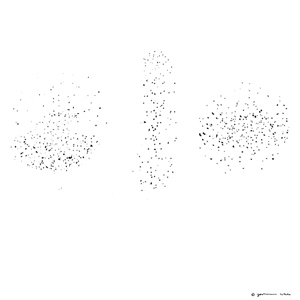Yoshi Wada, "Singing in Unison"
 While singing has frequently been part of Yoshi Wada’s other compositions, this is the first work of his to be released that dispenses with all other forms of instrumentation. Three male voices are all that is needed to create this intense and beautiful work captured during two performances in 1978. Combining the ultra modernism of the minimalist movement and ancient vocal traditions, Singing in Unison rivals any other modern vocal work I have heard thanks to its powerful mix of simple structures, complex harmonies and, above all, its emotional warmth.
While singing has frequently been part of Yoshi Wada’s other compositions, this is the first work of his to be released that dispenses with all other forms of instrumentation. Three male voices are all that is needed to create this intense and beautiful work captured during two performances in 1978. Combining the ultra modernism of the minimalist movement and ancient vocal traditions, Singing in Unison rivals any other modern vocal work I have heard thanks to its powerful mix of simple structures, complex harmonies and, above all, its emotional warmth.
 
In the 1960s, La Monte Young ditched his saxophone and began singing drones accompanied by his partner Marian Zazeela while Tony Conrad, John Cale and Angus MacLise created a heady wall of precise harmonization around them. The Theatre of Eternal Music would eventually collapse over disputes as to whether Young was a composer or these were group improvisations that belonged equally to all five of them. However, Young and Zazeela’s fascination with singing in an incredibly exact way continued and can be heard on albums like Dream House 78’17" (recorded with a new, Young-approved line up of the Theatre of Eternal Music) or backing Pandit Pran Nath on multiple recordings of this master of the Kirana Gharana style of Indian classical music. Young and Zazeela had invited Pran Nath to New York where he stayed, teaching interested musicians the demanding techniques he had developed throughout his practice of the craft.
One such student was Wada, who learned not only Pran Nath’s style and musical heritage but also Pran Nath’s use of dense harmonies that were possible using only the human voice (in a similar manner to how other composers were using instruments to achieve the same harmonic outcomes). In the liner notes, Wada describes his lessons with Pran Nath and his strict regime of practicing early every morning singing with a tambura. Mixed with memories from childhood of Buddhist monks chanting in prayer and his exposure to a group of women singing traditional Macedonian music, the seeds were sown for Singing in Unison. Wada envisaged a male alternative to the Macedonian women’s approach and combined it with the vocal training he had received from Pran Nath. Singing in Unison involves three male voices singing a wordless, timeless chant. It sounds like primal folk music and is far removed from the volume-intense bagpipe and installation works he would be better known for.
The group itself consisted of Wada, Richard Hayman (not the Boston Pops arranger!) and Imani Smith and it is hard to hear where the three voices differ as they merge into one another. A picture of a promotional postcard in the liner notes describes the work as "Improvisational singing in unison" but Wada’s own notes from 2012 suggest that the form was originally based on his own solo improvisations and then written down (there is a copy of a page from his handwritten score also included). The three voices largely follow the same undulating form, going up and down together. There are augmentations here and there along with deliberate shifts in pitch to bring out an array of microtonal intervals. It is these moments when Singing in Unison goes from being simply beautiful to being intensely spiritual, almost mystic. Yet, there is no spiritual agenda here, this is the power of music at what first to be its most basic level (the human voice) but tailored to hit our ears and our minds in all the sweet spots. Wada states his goal is communication and with Singing in Unison, he successfully manages to send a message of peace to the listener.
As with one of the previous Wada reissues on Em Records, the entire work is only available on vinyl with an extract from the complete recordings available on the CD edition. In the case of Singing in Unison, this means that the CD contains only one of the two recorded performances. I went for the vinyl as I wanted to get the whole lot but I may end up getting the CD too so I can listen to Singing in Unison without having to interrupt the music every 20 or so minutes. The performance included on the CD is a slightly better recording only because there is less background noise during the performances. However, both performances pack the same emotional punch as each other even if at times they stray a little from each other so perhaps there was more improvisation than I was giving the group credit for.
Improvisation or not, what matters most about Singing in Unison is that it pulls me in completely for its entirety. Wada’s music always takes me over but normally it is due to its relentlessness. With Singing in Unison, he leaves the shrill steamroller effect of bagpipes and big percussion aside to persuade the listener instead of conquering them.
 



